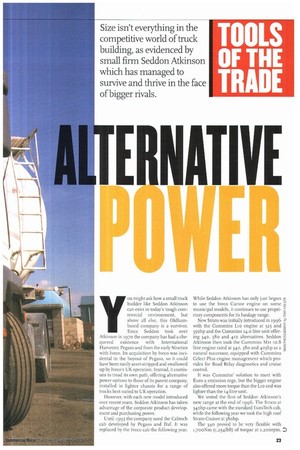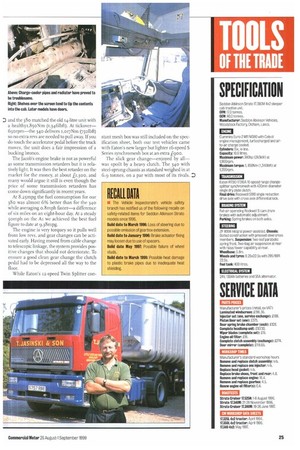ou might ask how a small truck builder like Seddon
Page 25

Page 27

Page 28

If you've noticed an error in this article please click here to report it so we can fix it.
Atkinson can exist in today's tough commercial environment, but above all else, this Oldhambased company is a survivor. Since Seddon took over Atkinson in 1970 the company has had a chequered existence with International Harvester, Pegaso and from the early Nineties with Iveco. Its acquisition by Iveco was incidental in the buyout of Pegaso, so it could have been easily asset-stripped and swallowed up by Iveco's UK operation. Instead, it continues to tread its own path, offering alternative power options to those of its parent company, installed in lighter chassis for a range of trucks best suited to UK operation.
However, with each new model introduced over recent years, Seddon Atkinson has taken advantage of the corporate product development and purchasing power.
Until 19 95 the company used the Cabtech cab developed by Pegaso and Daf. It was replaced by the Iveco cab the following year.
While Seddon Atkinson has only just begun Es to use the Iveco Cursor engine on some g municipal models, it continues to use proprietary components for its haulage range.
New Strato was initially introduced in 1996 -5 with the Cummins Lio engine at 325 and ft 35ohp and the Cummins 14.0 litre unit offer§ ing 340, 38o and 4ro alternatives. Seddon 8 Atkinson then took the Cummins Mrr ro.8 litre engine rated at 340, 38o and 4o5hp as a g natural successor, equipped with Cummins Celect Plus engine management which provides for Road Relay diagnostics and cruise control.
It was Cummins' solution to meet with Euro-2 emission regs, but the bigger engine also offered more torque than the Lro and was lighter than the 4-litre unit.
We tested the first of Seddon Atkinson's new range at the end of 1996. The Strata at 34ohp came with the standard EuroTech cab, while the following year we took the high roof Strato Cruiser at 38ohp.
The 340 proved to be very flexible with 1,700Nm (1,2541bft) of torque at 1,200rpm,
D and the 380 matched the old 14-litre unit with a healthyl,85oNm (t,3461bft). At tickover65orpm—the 340 delivers Lor7Nm Moll* so no extra revs are needed to pull away. If you do touch the accelerator pedal before the truck moves, the unit does a fair impression of a bucking bronco.
The Jacob's engine brake is not as powerful as some transmission retarders but it is relatively light. It was then the best retarder on the market for the money, at about it,3oo, and many would argue it still is even though the price of some transmission retarders has come down significantly in recent years.
At 8.25mpg the fuel consumption For our 380 was almost 6% better than For the 340 while averaging 0.8mph faster—a difference of six miles on an eight-hour day. At a steady 50mph on the Ai we achieved the best fuel figure to date at 9.38mpg.
The engine is very torquey so it pulls well from low revs, and gear changes can be activated early. Having moved from cable change to telescopic linkage, the system provides positive changes that should not deteriorate. To ensure a good clean gear change the clutch pedal had to be depressed all the way to the floor.
White Eaton's I2-speed Twin Splitter con
stant mesh box was still included on the specification sheet, both our test vehicles came with Eaton's new larger but lighter i6-speed S Series synchromesh box at an extra 9oo.
The slick gear change—enjoyed by all— was spoilt by a heavy clutch. The 340 with steel-sprung chassis as standard weighed in at 6.9 tonnes, on a par with most of its rivals. D
D With extra cooling, larger cab, and air-suspended rear axle, the 17.380 weighed in just 30kg heavier, which is better than average in this power sector.
The company's modern range of steel cabs is supplied by its parent company, but with selective use of some composite panels the truck takes on a separate identity. Lightest and cheapest is the waisted T6 version for longhaul domestic applications, while the fullgirthed T7 model provides greater internal width.
A high roof adds about 120kg to the weight of the basic T6 sleeper cab but it easily accommodates a second bunk, and the basic spec incorporates a high level of equipment as standard—including tinted glass, electric door windows and heated rear view mirrors.
Seddon Atkinson may achieve a degree of outward individuality but inside the cab is pure Iveco. The high roof gives plenty of standing room but we have doubts about the longevity of the central document case under foot. There is allocated stowage space but many drivers will throw their gear on the top bunk—a pity because it the thickest of the two. The original bottom bunk is a bit thin.
The A post and big mirrors obscure visibility on the near side. Outside the lockers would be more useful if they were larger.
The cab was a bit noisier than we expected. To encourage economic driving the RoadRelay bleeps when revs exceed 1,700rpm or drop below L000 rpm, which can become a bit tedious.
The chassis, built with a Rockwell single reduction drive axle, originates from Oldham. Rockwell S-cam drum brakes are fitted front and rear. No discs, but the brakes work well and linings will last longer than pads.
Air suspension on the drive axle costs more than steel but is worth it for the benefit it brings to driver comfort and protection of the load.












































































































